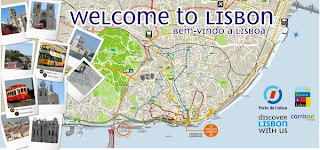Today, I took my third visit to the city of Lisbon,( from my Celebrity Equinox cruise ship) this time from the port of Alcantra. My plan was to tour the historic center including Baixa, Chiado, Bairro Alto, and the narrow warren of cobblestone streets in the charming Alfama district.
Armed with maps, euros, and a sense of adventure, I eschewed Celebrity and private shore excursions to explore on my own. I began with a journey into town using public transportation. I took tram #15, for 2.8 euros, directly to the grand Praca Rossio.
My goal was to begin by getting an expert overview from a local guide, with a 3-hour walking tour. I used http://www.insidelisbon.com, for 15euros.
I love walking tours--guided tours designed to showcase the city (history, culture, cuisine, government, public transportation, arts, language and more) through the eyes of a local-- and have taken them in many cities from Buenos Aires, to Casablanca, to Tallinn, to Barcelona.
Here is the rich itinerary that our group of ten followed:
· Visit the Rossio Square, the heart of both the old and new Lisbon. (this was our meeting point at 10AM.
· Learn how the old city of Lisbon was destroyedin the 18th century and then totally rebuilt to become the city of today.
· Learn about the favorite liqueur of many Portuguese and a typical drink in Lisbon - Ginjinha;
· Take a look at the Obelisk in the middle of Restauradores Square. It commemorates the Restoration of Portugal’s independence from Spain in 1640, after sixty years of Spanish rule.
· Marvel at the intricate Neo-Manueline architecture of theRossio Central Station.
· Learn about the Carnation Revolution of 1974 as you visit the beautiful Carmo Square, at the place where Portugal’s old dictatorial regime fell after 48 years.
· Walk through the elegant Chiado neighbourhood, with its old cafés, boutiques, theatres and bookstores.
· Enjoy a short trip on one of Lisbon’s vintage trams.
· Wander through the old maze of small squares and narrow alleyways of the Moorish Alfama neighbourhood, where time seems to have stopped one thousand years ago.
· Learn about Fado, Portugal’s own musical genre, as you go past the fado Museum and some of Alfama’s hidden, intimate Fado restaurants.
· Visit Lisbon’s Cathedral, the city’s oldest church, built in 1147.
· End your tour in Praça do Comércio, formerly the entrance hall of the city, one of Europe’s largest and most beautiful squares.
We walked up and down cobblestone streets. Inez, our tour guide, provided both a wealth of historical information about Lisbon, as well as interesting stories and insights into contemporary life in Lisbon. Moreover she was professional, smart, and friendly, and went out of her way to ensure that questions were answered and that everyone was enjoying the experience. For our group of ten, she even bought Belen Pastries and old tram tickets (up to Alfama).
 |
| Belen Pastries |
Alfama is a site not to be missed with its narrow, labyrinthine streets, the wrought iron balconies of often-decrepit houses that were so close they almost touched, and locals who know one another by name. Common sites were colorful clothes lines suspended from balconies, happy children playing, Fado cafes, and elderly women sitting in front of their houses, talking, laughing, legs outstretched, soaking up rays of sunshine.
I learned about a little-known incident that happened in Lisbon in 1506. Spurred on by fanatical priests, locals stormed into the Alfama district which was inhabited by Jews who had been forced to convert to Christianity. They hauled out these secret Jews and burned between 2,000 and 4,000 of them at the stake over the course of a few days – in the Rossio.
Near the Rossio, stands the 12th-century Church of Santo Domingo where there are 2 nearby monuments that commemorate this tragedy.
1) two off-white stone columns held together by an inscribed metal band emblazoned with words that apologized for the violence and intolerance against the Jewish people, signed on September 26, 2000, by the patriarch of Lisbon.
2) a large stone hemispheric sculpture with an inlaid Star of David. It was dedicated, in Portuguese, to the thousands of Jewish victims of intolerance and religious fanaticism who were killed in a fiery massacre on April 19, 1506 in this place. On the base of the statue was a quotation in Hebrew and Portuguese from Job 16:18: “O earth, do not cover my blood; may my cry never be laid to rest.”
After the tour ended, I spent time revisiting some of the sites and strolling along the bustling shop-lined Rua Augusta.
 |
| Lisbon's Christ Staue |
 |
| Ship docked near famous 25 of April Bridge |
I look forward to a return visit.
For more information, visit these videos:
See Rick Steves discuss the Alfama:
See Rick Steves discuss Baixa:
10 Reasons to visit Portugal Video:































.jpg)
.jpg)



